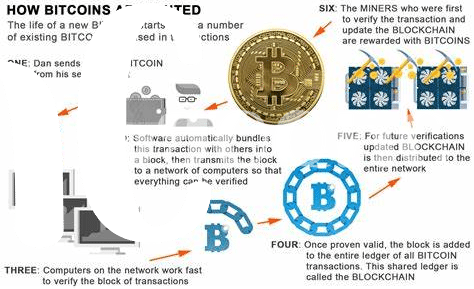🌍 Understanding the Basics of Bitcoin and Ethereum Mining

Picture two giants in a vast digital realm, one named Bitcoin and the other Ethereum. They’re like digital gold miners, constantly searching for treasure. But instead of shovels and pickaxes, they use powerful computers to solve complex puzzles. Each time they solve a puzzle, they are rewarded with a piece of digital gold, known as a cryptocurrency. This whole process is what we call mining. It might sound like a magical, effortless way to create money, but it requires a tremendous amount of power to keep those computers running. Think of all the electricity your home uses in a year; Bitcoin and Ethereum mining can use that much in just a day!
| ⚡ Energy Use | 🌎 Global Impact | 💻 Tech Requirements |
| Immense | Significant | High-end computers |
As we dive into the world of crypto mining, it’s crucial to understand the scales we’re talking about. It’s not just about the high electricity bills; it’s about how this demand for power affects our planet. From rural countryside to bustling cities, energy is pulled from all corners of the earth to feed this digital quest for crypto gold. Yet, as we stand at the crossroads of innovation and environmental responsibility, the question remains: how do we continue this digital treasure hunt without harming our world?
🔌 the Energy Demand: Facts and Figures Unveiled
Digging into the electricity use behind Bitcoin and Ethereum mining reveals a story of big power. Imagine if every time you wanted to send a letter, you needed to power up a small car engine just to get it to the mailbox. That’s kind of what happens when transactions for Bitcoin or Ethereum need to get verified and added to the digital ledger – it consumes a surprising amount of electricity. Computers all over the world enter a race to solve complex mathematical puzzles, and the winner gets to add the new block of transactions. But this race isn’t just about brainpower; it’s about who has the most electricity to keep their computers running. The numbers are staggering – it’s been compared to the energy consumption of entire countries. On one hand, it’s a testament to the security and robustness of the system. Yet, it brings up a serious question about sustainability. Can this digital gold rush really continue without leaving a mark on our planet? For a deeper understanding of how Bitcoin has evolved, including its energy consumption over the years, I recommend reading https://wikicrypto.news/from-2009-to-now-evolving-bitcoin-investment-approaches. It sheds light on the complexities and challenges faced by the crypto world in balancing growth with environmental responsibility.
🌱 Renewable Energy: Can It Power Crypto Mining?

Digging into the world of crypto mining, we often stumble upon the gnarly question of energy consumption. Imagine crypto mining like a giant digital treasure hunt where instead of shovels and maps, miners use computers to solve complex puzzles. This adventure, though thrilling, consumes a lot of electricity. Now, enter renewable energy, our planet’s beacon of hope. Picture the sun, wind, and water turning into the very power that drives this digital quest. Solar panels and wind turbines could potentially fuel the computers, making the chase for virtual gold a friendlier affair for our planet.
However, the road to green crypto mining isn’t without its bumps. The big question is whether there’s enough renewable energy to go around, especially in places where the sun hides, and the winds are shy. Yet, the spirit of innovation is relentless. From hydro-powered mining farms to solar-powered rigs, brilliant minds are crafting ways to merge the thirst for crypto with our need for a greener earth. The blend of technology and environmental consciousness paves a hopeful path, showing that with creativity and commitment, it might just be possible to mine our way to a better future, hand in hand with Mother Nature.
💨 Carbon Footprint: Evaluating the Environmental Impact

When we think about mining for cryptocurrencies like Bitcoin and Ethereum, it’s not just the treasure hunt in the digital world that should concern us; it’s the very real world impact it has, particularly on our planet’s health. The process requires an immense amount of electricity to power computer systems that solve complex puzzles, rewarding miners with new coins. This energy consumption has a significant carbon footprint, a term that refers to the total emissions of greenhouse gases caused by an individual, organization, event, or product. Think of it as the mark we leave on the planet. With the global push towards reducing carbon emissions, the environmental impact of such mining activities has come under scrutiny. It begs the question of whether the benefits of digital currencies outweigh the environmental costs. The conversation about sustainability and technology is ever-evolving, and understanding the nuances is crucial. For those looking to dive deeper into the intricacies of cryptocurrency and its broader implications, including how does bitcoin work investment strategies, a closer look at how does bitcoin work investment strategies can provide valuable insights. In striving for a greener future, considering the carbon footprint of our digital actions is a step we can’t afford to overlook.
🔄 Alternatives and Solutions in Crypto Mining
As we dive deeper into the digital age, it’s crucial to find greener paths for our tech activities, especially in areas like crypto mining which is known for its high energy appetite. Imagine a world where every digital coin mined brings us closer to sustainability, not further from it. This vision is getting closer to reality with some innovative shifts in the way we mine cryptocurrencies like Bitcoin and Ethereum. For starters, there’s a growing trend towards using renewable energy sources like solar, wind, and hydroelectric power. These eco-friendly alternatives not only reduce the carbon footprint associated with mining but also promise a more sustainable future for cryptocurrencies. Moreover, the adoption of energy-efficient mining hardware and techniques is on the rise, marking a significant step towards minimizing environmental impact.
Additionally, the concept of ‘green mining pools’ has emerged, where miners collectively use renewable energy to power their operations, creating a more sustainable mining environment. Some projects are even exploring the use of excess gas from oil fields—a byproduct that would otherwise go to waste—as a power source for mining, turning an environmental burden into a valuable resource.
| Alternative | Description | Environmental Benefit |
|---|---|---|
| Renewable Energy Sources | Using solar, wind, and hydro power for mining operations | Significantly reduces greenhouse gas emissions |
| Energy-Efficient Hardware | Adoption of mining devices that use less power | Decreases the overall energy consumption of mining |
| Green Mining Pools | Collective mining using renewable energy | Enhances the sustainability of mining operations |
| Utilizing Waste Gas | Using excess gas from oil fields for power | Turns waste into a resource, reducing environmental harm |
Embracing these alternatives not only helps in making cryptocurrency mining more environmentally friendly but also paves the way for a more responsible and sustainable future in the digital economy.
🤔 Public Perception Vs. Reality: What’s Often Overlooked

When talking about the environmental impact of crypto mining, many people have strong opinions—sometimes without all the facts. Interestingly, what often gets lost in the discussion is how perceptions might not fully align with the reality of the situation. For instance, while it’s true that mining operations for cryptocurrencies like Bitcoin and Ethereum use a lot of electricity, there’s a growing trend towards using green sources of energy. Yet, the public narrative sometimes misses this shift. The debate also tends to overlook what determines bitcoin’s price versus ethereum, focusing instead on more easily digestable figures like energy consumption stats. Additionally, solutions and innovations aimed at reducing the environmental impact of mining activities are often underreported. These include the development of more energy-efficient hardware and the use of excess natural gas for power mining operations, both of which could help mitigate environmental concerns. As discussions continue, it’s essential to bridge the gap between public perception and the nuanced realities, highlighting both the challenges and the strides being made towards more sustainable practices in the cryptosphere.
